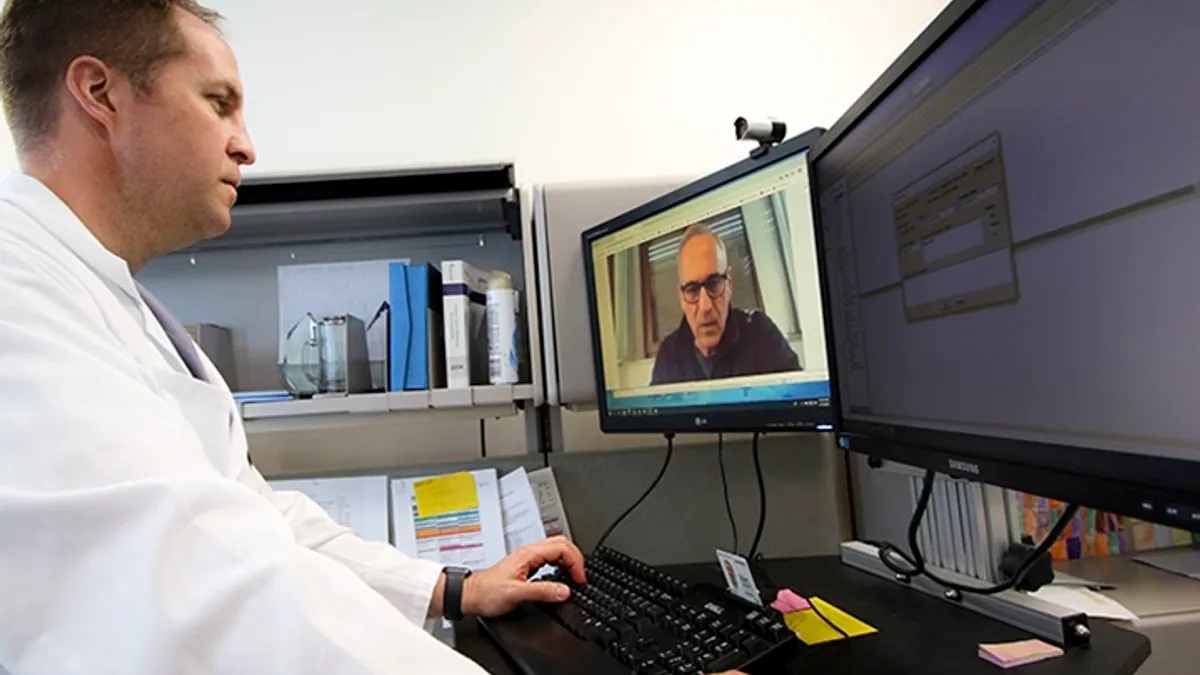Dive Brief:
- Telehealth claim lines increased 4,132% from June 2019 to June 2020, jumping from just 0.16% of all medical claim lines to 6.85% as patients turned to virtual care amid the coronavirus pandemic, according to new data from Fair Health's monthly tracker.
- However, the year-over-year increase was smaller than in May, when telehealth claim lines from the privately insured population jumped 5,680%.
- Virtual care claims fell 21% from May to June as states began to resume in-person treatment for non-emergency medical care, allowing patients to return to their doctor. However, telehealth usage remains extremely high compared with pre-COVID-19 utilization.
Dive Insight:
Patients turned to virtual care in droves in the early months of the pandemic, often due to a lack of alternatives as their state and local governments restricted availability of in-person care to free up healthcare resources to fight COVID-19. On a year-over-year basis, telehealth claim lines for privately insured people jumped 4,347%, 8,336% and 5,680% in March, April and May, respectively, according to nonprofit Fair Health's repository of 31 billion private insurance claims.
That makes June the second month in a row to see a decline in volume compared to the previous month.
Telehealth vendors reported historic utilization began to drop off in May and June as states started to allow hospitals and doctor's offices to restart elective procedures and treatments. Patients began trickling back for deferred in-person care as a result. According to data from EHR giant Epic, telemedicine visits accounted for 21% of total encounters by the middle of July, down from 69% at the initial peak of the pandemic in April.
This is still significantly higher than pre-pandemic telehealth rates (less than 0.01% of total visits, per Epic). But the big lingering question for virtual care companies — and providers who invested heavily to provide telemedicine in the early days of the public health crisis — is the severity and duration of the current downturn in telehealth use.
The Trump administration has moved to solidify some of the virtual care flexibilities it enacted earlier in the year, including proposing nine new permanent telehealth codes in August. CMS is allowing more than 135 additional services through telehealth for the duration of the national emergency. However, the most significant changes would require Congress to step in. The likelihood of meaningful near-term legislative action on the issue is low, despite bipartisan support, due to party rancor and deadlock over another COVID-19 relief bill in Washington.
But major telehealth players are betting some, if not all, of the flexibilities will remain in place, and are investing heavily to solidify their market presence. Teladoc purchased chronic care manager Livongo for a whopping $18.5 billion in early August in the biggest digital health deal to date, and Amwell filed an IPO — with an $100 million investment from Google — later that month.
Fair Health found the dip from May to June was consistent across the four U.S. regions, with the Midwest, Northeast, South and West each seeing large percentage increases in virtual care claim lines on a year-over-year basis in June that were smaller than those seen in May. The biggest drop between May and June utilization was in the Northeast, which saw a 33% decrease month to month.
Mental health conditions were already the No. 1 telehealth diagnosis in May, but they made up an even bigger share of telehealth visits in June. The diagnosis hiked from 40% to 44% of telehealth claim lines in the period, with notable increases in the Northeast and Midwest as people continue to struggle with conditions like depression and anxiety exacerbated by the ongoing pandemic.















